News from the Edible Demo Garden
August 2021: Growing Tomatoes and Physiological Problems
As the EDG team waits for the ripening of our tomatoes, we are sometimes discouraged because some of our plants or tomatoes do not look as perfect as we would want. What are those brown areas on the tomatoes and what’s causing the plant’s leaves to roll up? Often the cause is physiological, which is a fancy way of saying the symptoms are caused by environmental stresses and not by pests or disease.
Sun Scald
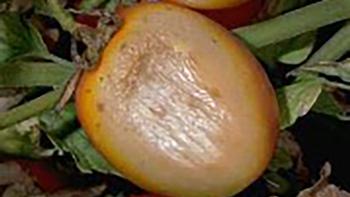
Cause: intense, direct sun on fruit
Prevention: protect fruit by using wire cages or plant tomatoes closer together. Provide shade by using shade cloth or burlap for at-risk tomatoes during the most intense heat of the day and avoid pruning any leaf cover that will open fruit to exposure. Fertilize to promote leaf cover (The Farm uses a very diluted solution of fish emulsion every other week after fruit is set.)
Leaf Roll
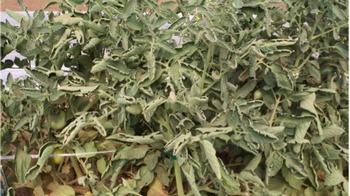
Causes: heat, drought, root damage
Prevention: harden off seedlings before planting, be careful not to damage roots, limit early pruning and prune lightly as plant grows, maintain consistent moisture, avoid too much fertilizer
Blossom End Rot
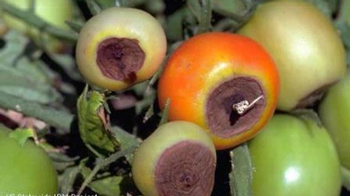
Cause: inconsistent soil moisture resulting in decreased uptake of calcium by the roots
Prevention: keep soil moisture at a consistent level especially during setting and ripening of fruit. Do not let soil dry out or become saturated and the best irrigation practice is a good long soak every few days, always monitor soil moisture during lengthy heat spells, apply two to three inches of mulch to retain soil moisture. Avoid applying too much nitrogen during early fruiting.
Catfacing
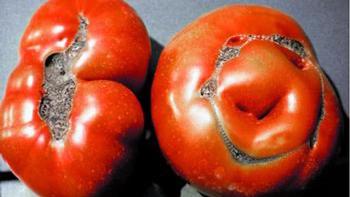
Causes: happens during flower formation, but exact causes are unknown. Catfacing is more apt to happen after cold or cool temperatures a few weeks before bloom and heavy pruning may increase it.
Prevention: choose smaller-fruited varieties, prune only when necessary to protect fruit.
Splitting/Cracking
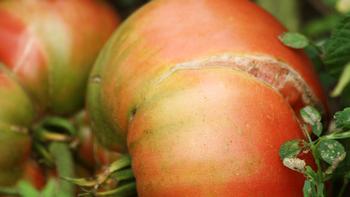
Causes: the inside of the tomato grows faster than the skin around it. This can follow an abundance of water applied to soil following drier conditions or wide fluctuations in air temperature.
Prevention: water consistently to avoid large fluctuations in soil moisture, apply mulch to reduce drying out of soil, maintain good foliage cover by pruning only when necessary, or choose smaller- fruited varieties.
Poor Fruit Set
Description: plant growth can be robust, but blossoms do not develop into fruit.
Causes: happens after days of temperatures less than 55°F or greater than 90°F, or high concentrations of smog (ozone).
Prevention: provide at least six hours of direct sunlight, to keep plants as healthy as possible to avoid damage from pests or disease. Provide consistent moisture, do not apply excessive nitrogen fertilizer prior to fruit set, but instead use it after you observe fruits developing.
Last Thoughts on Physiological Problems in Tomatoes
* Provide consistent soil moisture
* Prune lightly and with a purpose of paying attention to timing
* Protect the roots
* Be thoughtful when applying fertilizer, less can often be more and timing is important
* Mulch, mulch, mulch
* Tomatoes can be ripened indoors, so pick damaged tomatoes early before they begin to rot
* Don’t be squeamish about imperfect tomatoes, just cut off the damage and enjoy that juicy beefsteak tomato!
Read more on tomato care and other tomato problems
